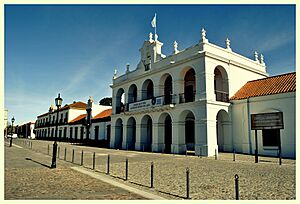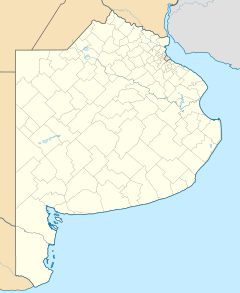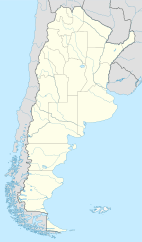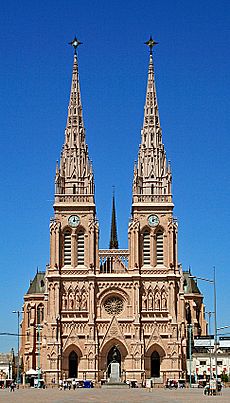Luján, Buenos Aires facts for kids
Quick facts for kids
Luján
|
|
|---|---|
 |
|
| Country | |
| Province | |
| Partido | Luján |
| Elevation | 21 m (69 ft) |
| Population
(2010 census)
|
|
| • Total | 106,899 |
| CPA Base |
B 6700
|
| Area code(s) | +54 2323 |
| Website | Official website: http://www.lujan.gov.ar/ |
Luján (say "loo-HAN") is a city in the Buenos Aires province of Argentina. It is about 68 kilometers (42 miles) northwest of the big city of Buenos Aires. Luján was started in 1755. In 2010, about 106,899 people lived there.
Contents
Discovering Luján's Famous Basilica
Luján is most famous for its huge church, the Basilica of Our Lady of Luján. This church looks like an old European cathedral with its tall, pointed towers. It was built to honor the Virgin of Luján, who is the patron saint of Argentina.
Why So Many Visitors Come Here
Every year, more than six million people visit the basilica. Many of them walk all the way from Buenos Aires to show their faith. Because of this, Luján is often called La Capital de la Fe, which means "The Capital of the Faith." Even if you are not religious, it is a popular place to visit for a day. You can find many restaurants that serve grilled food and shops selling souvenirs.
Building the Grand Basilica
A French architect named Ulderico Courtois designed the church. Building started in 1889 and finished in 1937. The church towers are very tall, reaching 106 meters (348 feet) high. It has a special copper roof and bronze doors. Inside, you can find a tiny statue of the Virgin, only 38 centimeters (15 inches) tall. There is also a very large and important organ that people are working to fix up.
Exploring the Enrique Udaondo Museum Complex
Luján is also home to the Enrique Udaondo museum complex. This is a group of museums where you can learn about life in Argentina a long time ago.
What You Can See at the Museum
The museum shows what colonial life was like in the house of the Viceroy (a ruler who governed a colony for a king). You can also see the old town hall. The exhibits include old art, military uniforms, fancy silverware, and many old vehicles.
Historic Vehicles on Display
Some of the cool vehicles you can see are the Plus Ultra, which was the first hydroplane (a type of airplane that can land on water) to fly from Europe to Argentina. You can also see La Porteña, which was Argentina's very first steam train.
Famous Prisoners of the Past
The museum also has old prison cells. Two important historical figures were held here. One was Colonel William Carr Beresford, a British commander from the 1806 British invasion. The other was General Cornelio Saavedra, who was the leader of Argentina's first national government in 1810.
Life with the Benedictine Monks
Since 1987, Benedictine monks have lived at the Abadía de San Benito (Saint Benedict Abbey) just outside Luján.
How the Monks Live and Help
These monks offer quiet places for people from the city to visit and reflect. They also support themselves by farming and by publishing books.
Getting Around Luján
Luján is the main town in the Lujan Partido, which is like a local government area. The city has both a railway station and a bus station. This makes it easy to travel to Luján from Buenos Aires. The nearby city of Mercedes is where the Bishop of Mercedes and Luján is based.
See also
 In Spanish: Luján para niños
In Spanish: Luján para niños




